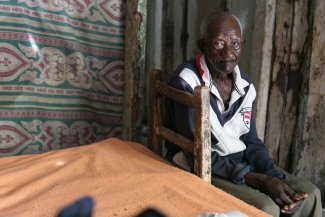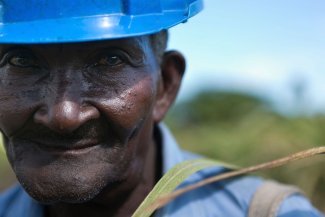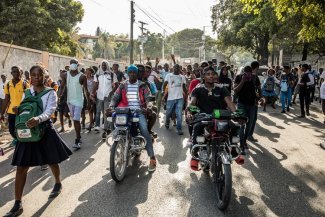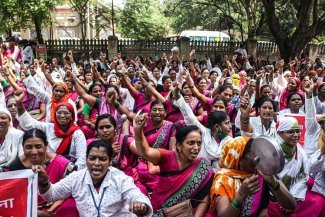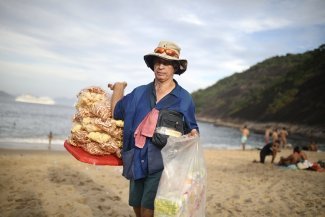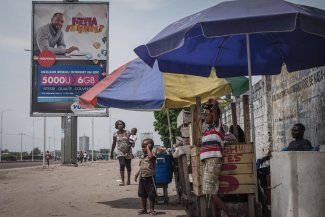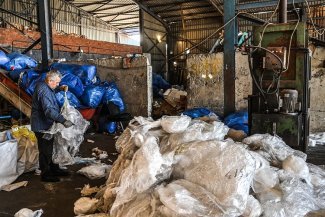
After being detained by Dominican immigration officers, a Haitian woman and her daughter are taken back to the border crossing in Elias Piña, 2 December 2021.
At around 10am, on 5 January 2022, in Villa Mella, Santo Domingo Norte, hundreds of vehicles make their way towards the city centre via the main gateway into and out of the country’s capital city, the Francisco J. Peynado bridge over the Isabela River. Among them is the big yellow bus of the Dominican Republic’s Immigration Department.
“I do not want to go back to Haiti. I came here to work. I beg you, let me stay,” a man wearing a white T-shirt and faded jeans pleads with the police. Like many of his fellow Haitians, he came in search of a better life but was detained that morning on his way to work.
Camiona is the word Haitians use to refer to the infamous yellow bus, similar to the ones used as school buses in the United States, but on this one, the windows have bars. For Haitians desperately fleeing widespread insecurity and dire poverty in their country, the sight of the yellow bus is a portent of deportation. Every week, thousands of workers try their luck in the Dominican Republic, crossing the border that divides the island of Hispaniola.
According to an immigration officer, the same operation repeats itself day after day, starting at 6am until well into the evening. “You must go back to your country. You are here illegally. Wherever you go in the Dominican Republic, we can find you. Go sort out your own country’s problems,” a man angrily shouts at a group of people he has just led into a large hangar belonging to the General Directorate of Migration, where the biometric data of each individual will be collected.
When they see the police, some try to appear unfazed, in an attempt to go unnoticed, others run for it, leading to chases that often end with violent detentions. A man tells Equal Times he was mistreated during his arrest, pointing to his wounded leg and torn trousers.
According to GARR (Support Group for Returnees and Refugees), in 2021 alone, more than 28,000 Haitian migrants were repatriated across the border between Haiti and the Dominican Republic. GARR is a Haitian non-governmental organisation that fights against the discrimination and injustice suffered by Haitians abroad, particularly in the Dominican Republic. Following the decision to limit access to healthcare for foreign nationals, “many pregnant migrants have been driven out of public hospitals, detained and subsequently deported by Dominican immigration officials”, the organisation reports.
Violent incidents of this kind appear to be on the rise ever since the Dominican authorities took new measures to reduce the number of undocumented people in the country. This includes people who cross the border occasionally to seek work or medical treatment, but also those who have been settled in the country for a long time.
The tough stance on immigration was a campaign promise of President Luis Abinader, who was elected to office in 2020. “Haitians who come to the Dominican Republic must have a work permit and be in compliance with the law. And once their job is done, they must return to their country,” he said shortly after taking office. He also launched the construction of a 190-kilometre-long fence along the border between the two countries, citing the security threat posed by gangs that have taken control of several regions in Haiti as the reason.
Cheap labour
The Dominican Republic – one of the Caribbean’s top tourist destinations – has experienced one of the fastest economic growth rates in the region over the past decade, according to the OECD. This strong performance is driven mainly by the tourism, services and construction sectors.
Relations between the two states sharing the same island have always been stormy. But this has never hindered trade and labour flows, from which the Dominican Republic has long benefited. “Haitians have always provided cheap labour,” says Haitian pastor Marc-André Louis. This father of three, married to a Dominican woman, has lived in the east of the island since 2009. The majority of his parishioners are Haitians without residence permits.
According to the pastor, Haitian migrants mostly take on jobs that Dominicans do not want to do, especially in agriculture and construction. “It’s very hard to find a Dominican willing to work in these two sectors, because they don’t want to work so hard. Haitians, on the other hand, are used to it. Creole is the language heard among the labourers on all the building sites in the Dominican capital.”
Manuel Matos is the head of the Association of Agricultural Producers of San Juan Valley, one of the country’s leading agricultural regions. For him, the picture is very similar in the countryside, where 95 per cent of the workers are Haitian, despite the law requiring that 80 per cent of a company’s employees be Dominican. “It is hard to respect the limit on the number of foreign workers here. According to the regulations, it should not exceed 20 per cent. This law will never be enforceable,” says the director of the agricultural association in an interview with the EFE news agency. He goes on to explain that Dominican day labourers often prefer to go to the cities to work as motorbike taxi drivers.
Based on data from the 2017 National Immigrants Survey (ENI-2017), only 16 per cent of Haitians hold written employment contracts, compared to 61 per cent among the rest of the foreign workforce.
Deprived of contracts, these workers receive low wages without any social benefits. “We don’t find work every day. And those who are willing to hire us offer 500 pesos (approximately €7) for a day’s work in construction.
Pay is even lower in agriculture. Still, it’s better than nothing back in Haiti,” says Johnny, a 33-year-old Haitian living in a small, whitewashed house in Cibao Valley.
And yet, according to Matos, Haitian immigrants “produce much of the food we eat and build many of the houses and buildings where Dominicans live and work, and they do so at a low cost. Without this cheap labour, the cost of living would be higher in the Dominican Republic.”
Just three kilometres from the beach resort of Punta Cana, one of the most popular tourist destinations, is a large open-air landfill, where hotels and other big companies dump their waste day after day. Around 20 men and women can be seen sifting through the rubbish. Some of them are collecting leftover food waste to feed their animals. Others are collecting plastic to sell to recycling companies, like Gabriel, a man in his thirties who lives with his child just a stone’s throw from the dump.
Collecting plastic waste earns him less than €5 a day. “I spend my life here picking up plastic for a company that comes and collects it. We’d heard there were a lot of tourists in town. I came here in search of work. But since 2019 I have been unable to find a job in Punta Cana because I’m not in compliance with immigration regulations.”



